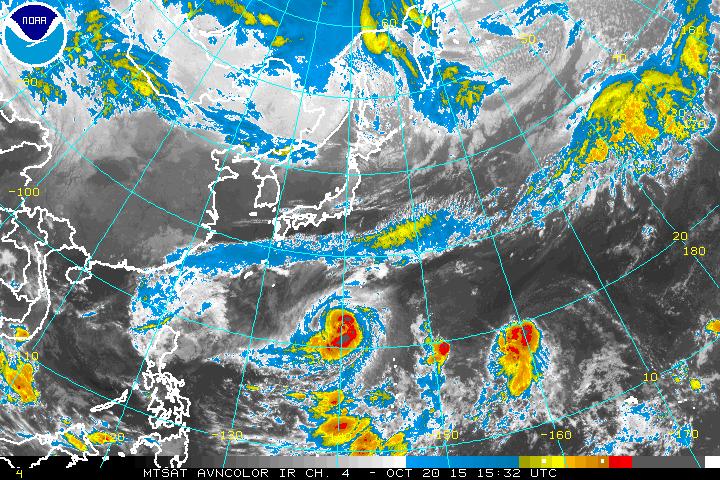This infrared imagery shows lots of tropical cyclone activity, sucking heat out of the ocean and radiating it off into space at those bright red spots. This year has record cyclone activity in the north Pacific, which means record amounts of heat being removed from the oceans.
Disrupting the Borg is expensive and time consuming!
Google Search
-
Recent Posts
- Michael Mann Again
- Over The Target
- Michael Mann’s Latest Research
- “an amazing documentary dismantling the climate change theory”
- The World’s Greatest Climate Scientist Speaks Out
- Startling New Revelation
- Just An Illusion
- Climate Conditioning
- Fact Checking Reuters
- No Correlation
- I Offended Their Religion
- The High Priest Has Forbidden Questioning His Religion
- Hiding And Rewriting History
- Fact-Free Economist
- Academic Tipping Points
- Desperate Academics
- Climate Misinformation
- Unreliable And Toxic
- Unreliable And Toxic
- Fossil Fuels To End Risotto
- HG Wells “CHANGES IN THE WORLD’S CLIMATE” 1920
- SCIENCE : THE ICE AGE COMETH?
- Climate Misinformation
- “Goodbye New York. Goodbye Washington”
- Climate Refugees
Recent Comments
- Mike Haseler (Scottish Sceptic) on Michael Mann Again
- Jimmy Haigh on Michael Mann’s Latest Research
- jb on Michael Mann Again
- Bill Odom on Michael Mann Again
- Richard E Fritz on Michael Mann Again
- Francis Barnett on Michael Mann’s Latest Research
- Disillusioned on Michael Mann Again
- arn on Michael Mann Again
- Conrad Ziefle on Michael Mann Again
- arn on Michael Mann Again



Evaporating water absorbs about 950 Btu/lb. Over an hour a pound of evaporating water absorbs 278 Watts (950/3.412). ToA is 340 W/m^2. CO2 RF is 2.0 W/m^2. Water is the heat moving champion of the globe.
Nic, I found this on water and heat.
So Evaporation of water is 2,500,000 J/kg. http://www.theweatherprediction.com/habyhints2/524/
And since most of this energy is taken from the nearby sea water – it will cool
Specific Heat Sea Water = 4,009 J/kg oC 2,500,000/4,009 = 623 or 623 kg by 1- C
Since there is 1,000 Kg per m^3 or 100 Kg per cm-m^2, 1″ (2.54 cm) of water sublimated will cool the next (623/100)/2.54 = 2.45″ of water 1 oC.
Oh yea, the average amount of evaporation on open ocean (non-ice) is around 140 cm. That’s how the oceans cool.
Wiki Pacific Typhoons 1998 & 2015 pages list
1998 –
Total depressions 22 official, 5 unofficial
Total storms 15 official, 3 unofficial
Typhoons 8 official, 1 unofficial
Super typhoons 3 unofficial
2015 – to date
Total depressions 35
Total storms 25 official, 1 unofficial
Typhoons 16
Super typhoons 8 (unofficial)
How many inches of water do you think each sq meter of ocean got sucked up by these systems? No wonder the Pacific temperatures are not close to 1998.
Evaporation from the Surface of the Globe – They peg the total energy for evaporation ocean plus land at 1.26 X 10E24 or 25 pecent of ‘energy in’ at the surface.
paper here – http://www.eolss.net/sample-chapters/c07/e2-02-03-02.pdf
http://www.engineeringtoolbox.com/fluids-evaporation-latent-heat-d_147.html
Btu/lb 970.4
lb/kg 2.204
Btu/kg 2,138.8
kJ/Btu 1.055
kJ/kg 2,256.4
J/kg 2,256,393
Hey I thought the climate liars said the heat was hiding at the bottom of the ocean … safely out of the cyclones spinning on the surface 😉
So the cyclones are trying to offset the El Niño?
El Ninos are also a release of energy from the ocean.
I’m sure all this powerful stuff must be hidden somewhere there in the IPCC climate models! It’s just that you can see it there easily.
Perhaps ocean heat is like solar neutrinos that oscillate away before being detected. With modern “science,” all things are possible !
Oliver, congratulations on NOT playing the same song over and over. In a few days I will have a question for you in your field, just no time now. Thanks
First off, a discussion of units.
A watt is a metric unit of power, energy over time, not energy per se. The metric energy unit is the joule, English energy unit is the Btu. A watt is 3.412 Btu per English hour or 3.600 kilojoule per metric hour.
In 24 hours ToA power of 340 W/m^2 will deliver 1.43 E19 Btu to a spherical surface with a radius of 6,386 km. The CO2 RF of 2 W/m^2 will deliver 8.39 E16 Btu, 0.59% of the ToA.
At 950 Btu/lb of energy, evaporating 0.74 inches of the ocean’s surface would absorb the entire ToA, evaporating 0.0044 inches of the ocean’s surface would absorb the evil unbalancing CO2 RF.
More clouds. Big deal.
ToA spherical surface area, m^2 5.125.E+14
W = 3.412 Btu/h 3.412.E+00
ToA, 340 W/m^2, Btu/24 h 1.43E+19
CO2 RF, 2 W/m^2, Btu/24 h 8.39E+16
Ocean surface , m^2 3.619E+14
m^2 = 10.764 ft^2 1.076E+01
Ocean surface, ft^2 3.895E+15
Water density, lb/ft^3 62.4
Lb of water in 1 foot of ocean 2.431E+17
Evaporation, Btu/lb 950.0
Amount of ocean evaporation
Feet needed to absorb ToA 0.062
Inches needed to absorb ToA 0.74
Feet needed to absorb CO2 RF 0.0004
Inches needed to absorb CO2 RF 0.0044
Check ’em Danno.
Annual accumulated cyclone energy and SST:
http://climategrog.files.wordpress.com/2013/04/amo_ace-no_detrend-1925adj.png
https://climategrog.wordpress.com/?attachment_id=215